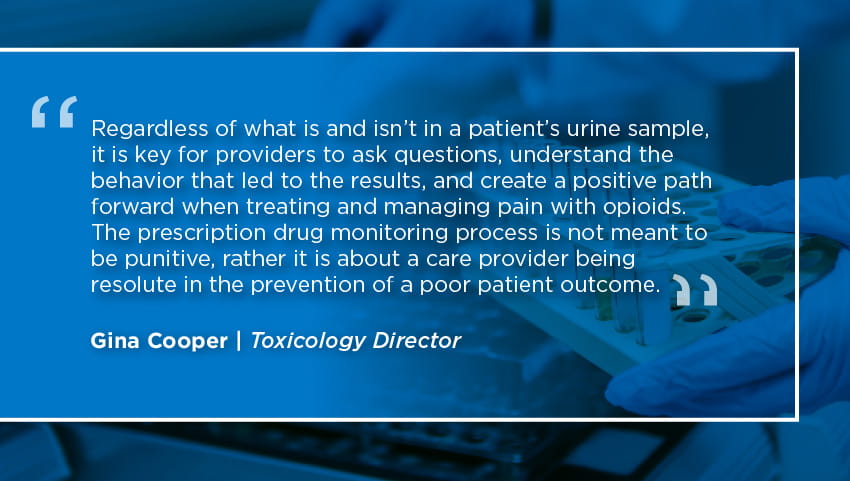Article

At DRUGSCAN, we work hand in hand with our clients to help them achieve positive patient outcomes through early detection achieved by prescription drug monitoring. Having a clear understanding of how patients are using their prescription medications is essential to identify and halt prescription misuse and abuse before it escalates into a substance use disorder.
Many patients have difficulty recognizing prescription medication as risky or unsafe. Since it is prescribed by a healthcare provider for a legitimate health concern, it is perceived as safe. Generally speaking, these medications can be safe when used according to the dosing instructions and can be valuable in bringing therapeutic response to the patient. However, it is important that patients are educated before the onset of treatment with a controlled substance so that all risks for harm can be understood. As advocated by the World Health Organization, a systematic approach can help improve the prescribing process and minimize patient misunderstanding. This in turn can help stop patient misuse of prescriptions. According to this six-step approach physicians should:
Additionally, the Agency for Healthcare Research and Quality (AHRQ) has published these tips to help physicians conduct an effective medication interview with patients.
To obtain or verify a list of the patient's current medications, you should inquire about:
Full dosing information should be captured, if possible, for each medication. This includes:
More than half of U.S. adults are regularly take prescription medications, many of them psychotropics and controlled substances. With so many Americans taking multiple prescription medications, there’s really never been a more important time for providers to consider their prescribing processes and ensure that patients understand risks of medication misuse and abuse. Implementing a toxicology screening process to identify what medications are being taken by patients can equip providers with objective data to use when implementing and changing treatment plans. DRUGSCAN is here to help.
At DRUGSCAN, we focus on urine drug testing for our toxicology screening services. While urine screening cannot link the amount of drug or metabolite in urine back to an amount of drug ingested, it can tell the prescriber the drug detected is there or not there, while also providing them with a window of detection to help them determine when the use occurred.
When working with DRUGSCAN, we coach you through the entire specimen collection process, with reports available within 48-hours (from the time the specimen is received) with confirmation results. We also provide data on demand based on client requests.
At DRUGSCAN we advocate for medically necessary and clinically relevant testing. One way we encourage only necessary testing is by providing an initial screen and reflexing confirmatory testing as needed based on the screening results. This testing process allows us to keep patient bills as low as possible. Expensive bills for toxicology testing can be a barrier to care for many patients. At DRUGSCAN, our goal is to never be responsible for a barrier. Our goal is to be a partner in the care of patients, continually striving for quality outcomes.
One of the most challenging tasks for providers is to determine the best treatment plan for a patient whose urine drug test shows signs of medication misuse. In pain management, for example, signs of misuse must be addressed in the name of prevention. However, it is important to recognize that pain still has to be managed. As such, these cases become quite complex.
Understanding what appears to be medication misuse is crucial in order to determine the best path forward for a patient. What appears to be medication misuse often has an explanation that allows providers to understand patient concerns, challenges, and barriers. This likely still means that a change in treatment plan is in order, but also allows for a new treatment plan that is in the best interest of the patient.
Questions that might be important to ask and allow for greater understanding of patient dosing behavior may include:

“Regardless of what is and isn’t in a patient’s urine sample, it is key for providers to ask questions, understand the behavior that led to the results, and create a positive path forward when treating and managing pain with opioids. The prescription drug monitoring process is not meant to be punitive, rather it is about a care provider being resolute in the prevention of a poor patient outcome.”
Gina Cooper, Toxicology Director at DRUGSCAN, MSN, RN NE-BC
With more than 35 years of testing experience, DRUGSCAN is dedicated to helping you make crucial decisions that affect the health and safety of your patients or employees with increased confidence. Our CAP-accredited and SAMHSA- and CLIA-certified lab operates 24/7, with all testing performed in-house — getting you the results you need fast and efficiently so you can focus on what matters most, your patients.
To get started with DRUGSCAN today please contact us or call us at 1.800.235.4890.